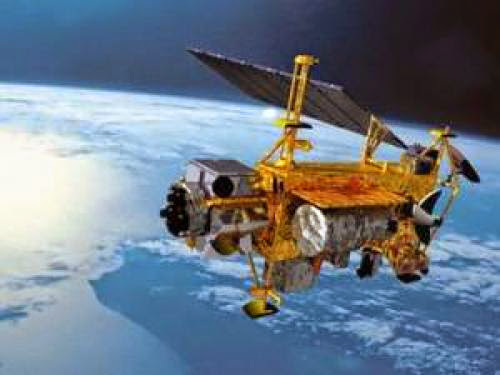SEPTEMBER 16, 2011 - A NASA SATELLITE WILL FALL BACK TO OUR PLANET at five miles per second, and it could hit us as early as September 24. THE UPPER ATMOSPHERE RESEARCH SATELLITE (UARS) "is expected to re-enter Earth's atmosphere in late September or early October 2011, almost six years after the end of a productive scientific life. Although the spacecraft will break into pieces during re-entry, not all of it will burn up in the atmosphere." That statement comes from NASA'S WEBSITE."THE ACTUAL DATE OF RE-ENTRY IS DIFFICULT TO PREDICT," says NASA, "because it depends on solar flux and the spacecraft's orientation as its orbit decays. As re-entry draws closer, predictions on the date will become more reliable." UARS weighs 6.5 tons (13,000 pounds). It is 35 feet long by 15 feet wide.NASA CALLS THE DANGER OF INJURY OR PROPERTY DAMAGE by the falling satellite "extremely small." Even so, they caution anybody who might find something that could be a piece of UARS to not touch it. "Contact a local law enforcement official for assistance," NASA warns. The satellite is expected to break up into many smaller chunks as it plows through the atmosphere in an uncontrolled free fall.THE "ESTIMATED HUMAN CASUALTY RISK" is about 1 in 3,200 according to a NASA document. Details can be found on Page 8 of a PDF document titled "Re-entry and Risk Assessment for the NASA Upper Atmosphere Research Satellite (UARS)."THE ODDS OF UARS INJURING SOMEONE ARE NOT REASSURING, HOWEVER. 1 in 3,200 is actually rather high. The National Weather Service (NWS) puts the odds of being struck in your lifetime (est. 80 years) at 1 in 10,000. NWS says your chance of being struck by lightning in a given year (reported deaths + injuries) is 1 in 1,000,000. Consider how cautious you are when there is a lightning storm near you. Now consider how cautious you will be as UARS plummets toward us. Your chances of winning the Illinois lottery, by the way, are approximately 1 in 14,000,000.UARS WAS OFFICIALLY DECOMMISSIONED ON DEC. 14, 2005. It was designed to orbit Earth at an altitude of 375 miles for three years, but six of its ten instruments are still functioning. Most of the UARS atmospheric composition measurements are being continued with EOS Aura and all of the UARS solar irradiance measurements are being continued with SORCE. The satellite was launched in 1991 by the Space Shuttle Discovery.
Origin: we-are-believe.blogspot.com


0 comments:
Post a Comment